BBC Proms: The Marriage of Figaro, Glyndebourne Festival review - merriment and menace | reviews, news & interviews
BBC Proms: The Marriage of Figaro, Glyndebourne Festival review - merriment and menace
BBC Proms: The Marriage of Figaro, Glyndebourne Festival review - merriment and menace
Strong Proms transfer for a robust and affecting show
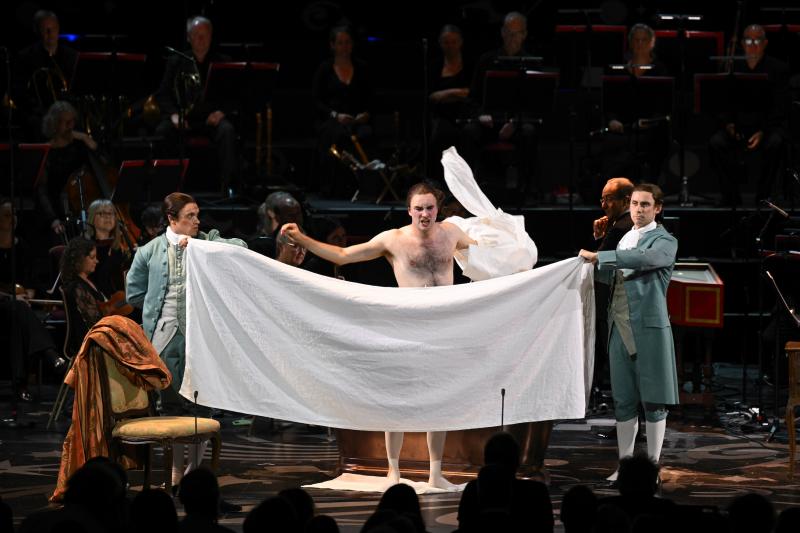
One door closes, and another one opens. A lot. It’s extraordinary what value those two simple additions to the Royal Albert Hall stage lent to Glyndebourne’s performance of The Marriage of Figaro at the Proms.
Combined with some niftily manoeuvred furniture, minimal suggestions of a garden for the outside scenes, and the genius touch of a bathtub for the Count in Act Three, a few strategically deployed items made sure that we enjoyed pretty much a full staging of this signature piece for the Sussex house.
The cast, in period costume, used the width of their space well and climbed, when necessary, around the steps on which the Orchestra of the Age of Enlightenment played. Talia Stern, director for this visit, adapted Mariame Clément’s much-acclaimed new production with economy and intelligence. No one in a full, and hugely enthusiastic, house will have felt short-changed by a mere “concert performance”. This well-conceived one-night transfer meant that the dramatic and vocal strengths of the Glyndebourne show did more than just survive the move. Singers projected effectively into the vast barn around them, and even the most intimate moments – notably, the Countess’s pair of stricken arias (pictured above: Louise Alder with Pippa Barton) – never felt like faraway events. As for the OAE, they exploited their enhanced visibility to make a thrillingly up-front and attention-grabbing sound, with woods, horns, trumpets and Adrian Bending’s hard-edged timpani major characters in their own right. Conductor Riccardo Minasi’s tempi varied between whirlwind excitement – as in a hard-driving overture – and odd patches of languor when he almost seemed to make the singers stall. Just occasionally, a generally bustling production seemed to go slow-mo.
This well-conceived one-night transfer meant that the dramatic and vocal strengths of the Glyndebourne show did more than just survive the move. Singers projected effectively into the vast barn around them, and even the most intimate moments – notably, the Countess’s pair of stricken arias (pictured above: Louise Alder with Pippa Barton) – never felt like faraway events. As for the OAE, they exploited their enhanced visibility to make a thrillingly up-front and attention-grabbing sound, with woods, horns, trumpets and Adrian Bending’s hard-edged timpani major characters in their own right. Conductor Riccardo Minasi’s tempi varied between whirlwind excitement – as in a hard-driving overture – and odd patches of languor when he almost seemed to make the singers stall. Just occasionally, a generally bustling production seemed to go slow-mo.
The cast not only commanded their key arias, and smoothly meshed in the peerless ensemble scenes. They acted with a ham-free vigour and commitment that filled the huge hall. In general, and despite the billows and frills of the 1780s frocks, Clément and her singers deliver an emotionally dark Figaro. Thanks to rich characterisation and deft stagecraft, it nonetheless drew waves of laughter from around the hall at many points. That ambivalence felt true to Mozart, and to Figaro’s perpetual quicksilver coupling of surface farce with underlying pain. 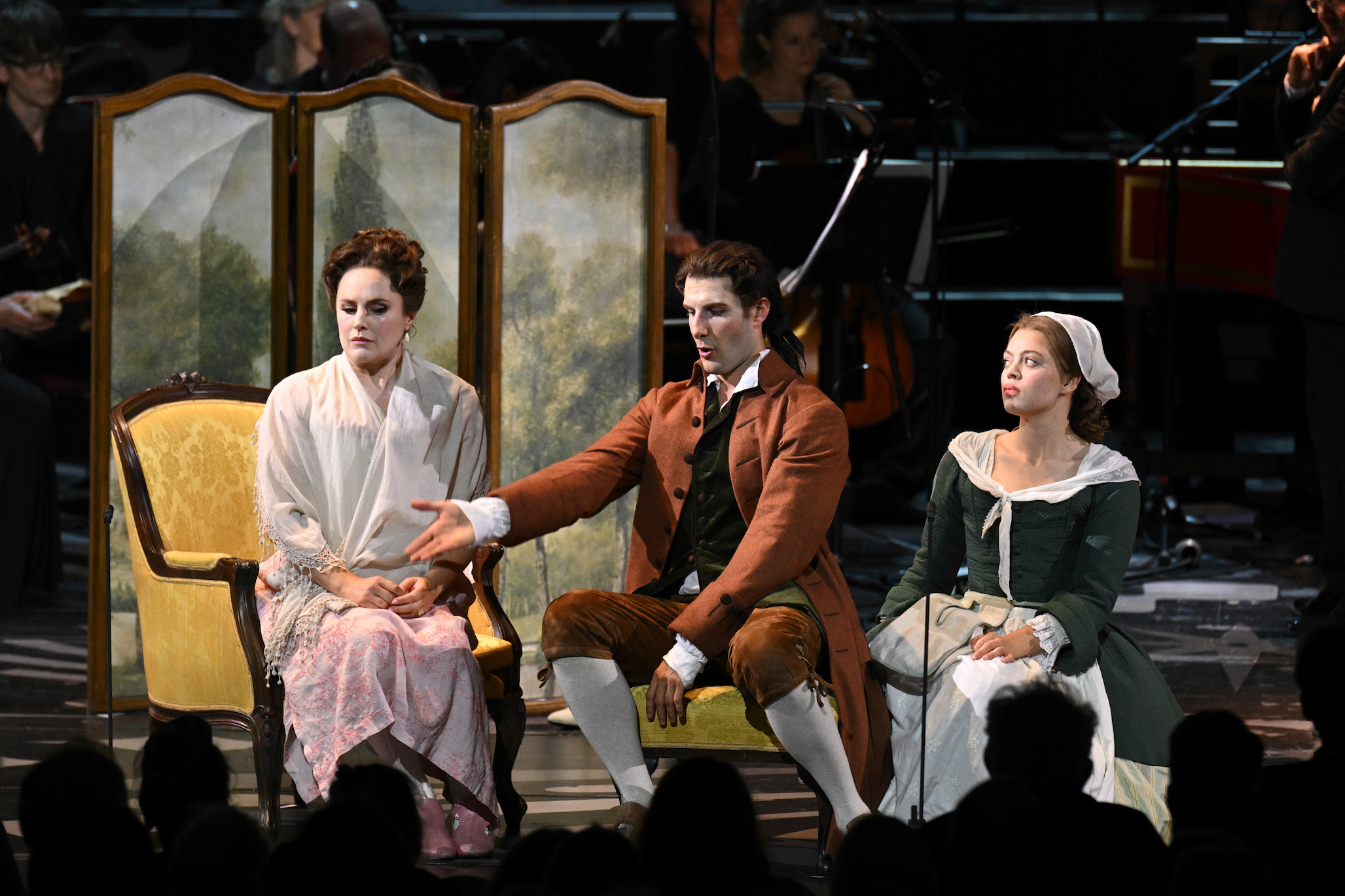 A tough, even menacing, Count Almaviva, Huw Montague Rendall (pictured above with Louise Alder and Joanna Wallroth) combined vocal power and nuance with a dangerous physicality. He mingled imperious desire with an edge of volatile rage. His pursuit of Susanna, and confrontations with Figaro, teetered on the brink of violence (or went right over, in one scene with the long-suffering Countess), while numbers such as “Vedro mentr’io sospiro” exhibited a scary rasp and bite.
A tough, even menacing, Count Almaviva, Huw Montague Rendall (pictured above with Louise Alder and Joanna Wallroth) combined vocal power and nuance with a dangerous physicality. He mingled imperious desire with an edge of volatile rage. His pursuit of Susanna, and confrontations with Figaro, teetered on the brink of violence (or went right over, in one scene with the long-suffering Countess), while numbers such as “Vedro mentr’io sospiro” exhibited a scary rasp and bite.
Louise Alder’s Countess tempered her refined melancholy with spirit and even playfulness when the table-turning plot hatched with Susanna begins. Her “Porgi amor” hinted at ardent sorrow but felt slightly constrained; in contrast, “Dove sono” spanned a shadowed rainbow of emotion with exemplary feeling, tone and diction. The little child (Pippa Barton) who accompanied her – a dream daughter? – was one of a handful of directorial touches that made this otherwise fairly “classic” reading of the work not entirely mainstream.
On the servants’ side, Tommaso Barea’s Figaro had a heft, depth and authority that made him not just a plausible antagonist for the decadent Count but – in this revolutionary age – a credible future replacement. I’ve seen and heard wittier Figaros, but Barea had presence, agility (both vocal and physical) and a sense of muscle behind his upwardly-mobile machinations. He made, for example, “Non piú andrai” not some genial send-off for the scamp Cherubino but a gloating, hands-on expulsion of a too-charming rival for backstairs supremacy. 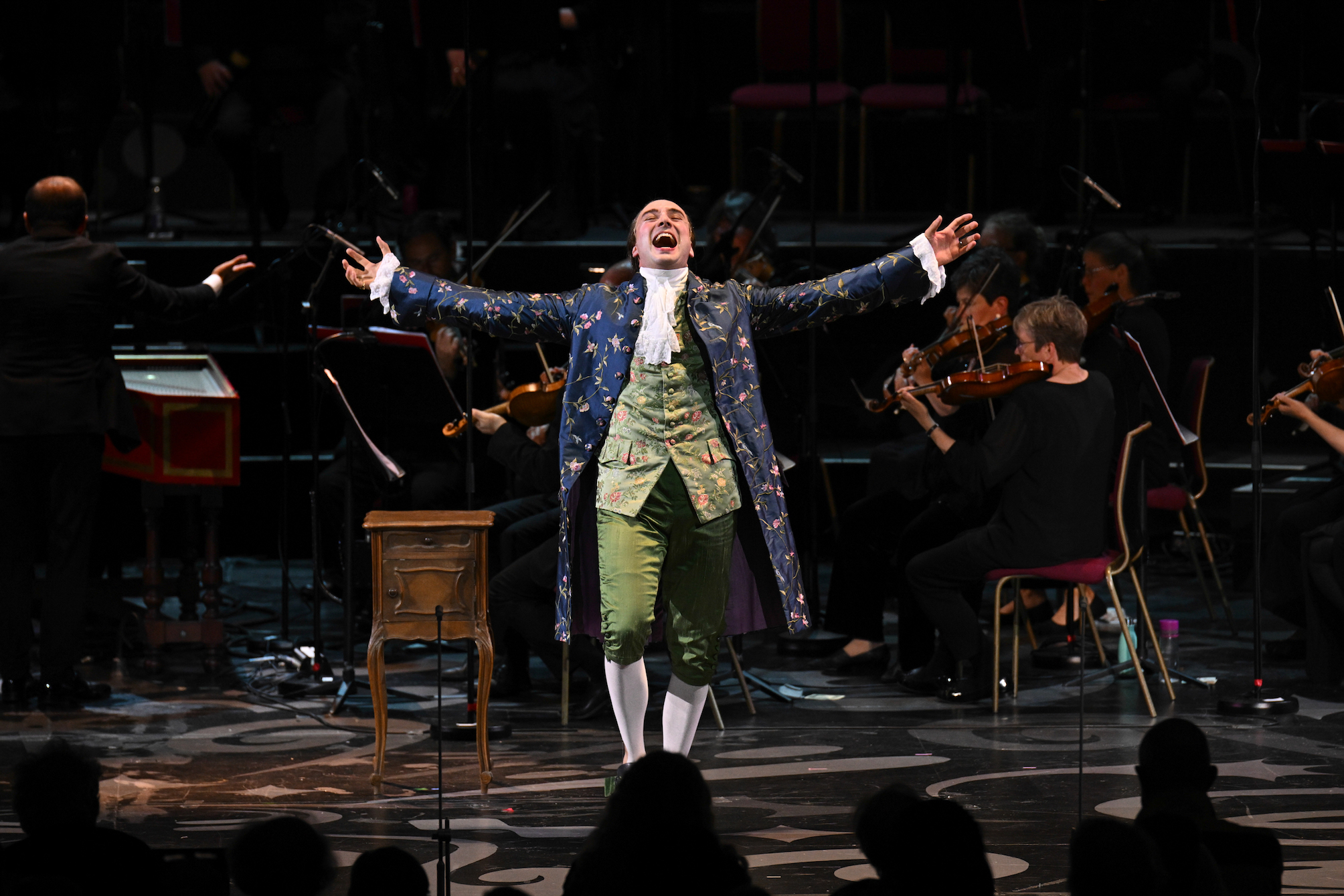 As Susanna, Johanna Wallroth always gave a wistful and lyrical undertone to her smart and pert intrigues. In “Deh, vieni, non tardar” – the smouldering serenade that gullible Figaro thinks she means for the Count – this quality bloomed into a beautifully paced and phrased sensuality. However, Adèle Charvet as Cherubino (pictured below with Johanna Wallroth) at times threatened to upstage the whole company: black-clad, unusually imposing, not just a silly charmer but addictively loveable, with a winning touch of vulnerability that his/her (finally triumphant) efforts to sing “Voi che sapete” showed.
As Susanna, Johanna Wallroth always gave a wistful and lyrical undertone to her smart and pert intrigues. In “Deh, vieni, non tardar” – the smouldering serenade that gullible Figaro thinks she means for the Count – this quality bloomed into a beautifully paced and phrased sensuality. However, Adèle Charvet as Cherubino (pictured below with Johanna Wallroth) at times threatened to upstage the whole company: black-clad, unusually imposing, not just a silly charmer but addictively loveable, with a winning touch of vulnerability that his/her (finally triumphant) efforts to sing “Voi che sapete” showed. 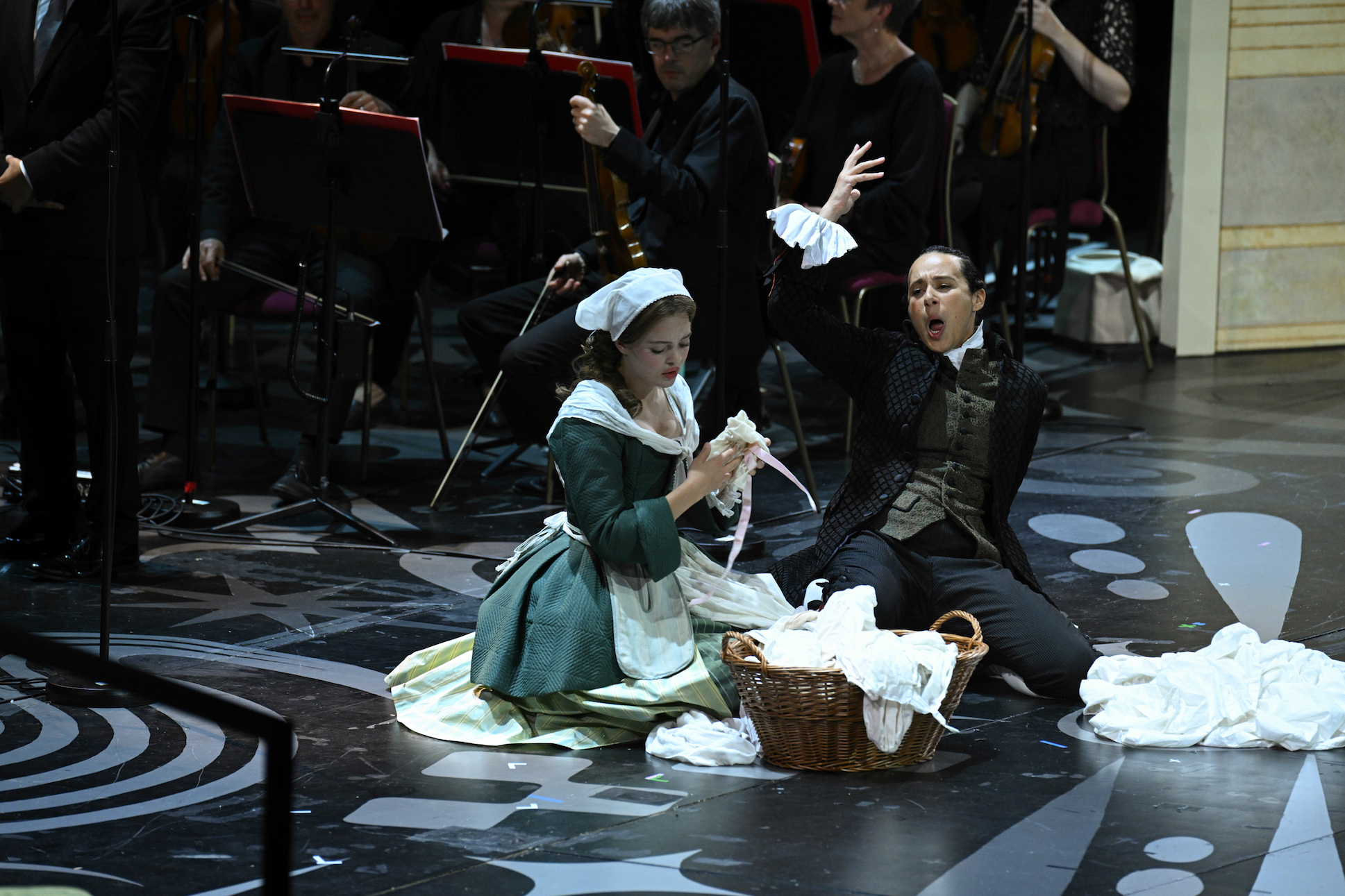 Some dainty embellishments to that number confirmed the sense that Minasi had encouraged his singers liberally to ornament their lines. That’s authentic practice, and it almost always worked.
Some dainty embellishments to that number confirmed the sense that Minasi had encouraged his singers liberally to ornament their lines. That’s authentic practice, and it almost always worked.
From the trio of old-timers – Alessandro Corbelli’s Bartolo, Robert Forrest’s Basilio, Madeleine Shaw’s Marcellina – we could appreciate sturdy character sketches, even if Corbelli's Bartolo overdid his orthopaedic challenges a bit. And Elisabeth Boudreault as Barbarina made an outsize contribution, haunting and poignant, with her astonishing minor-key lament for a lost pin. 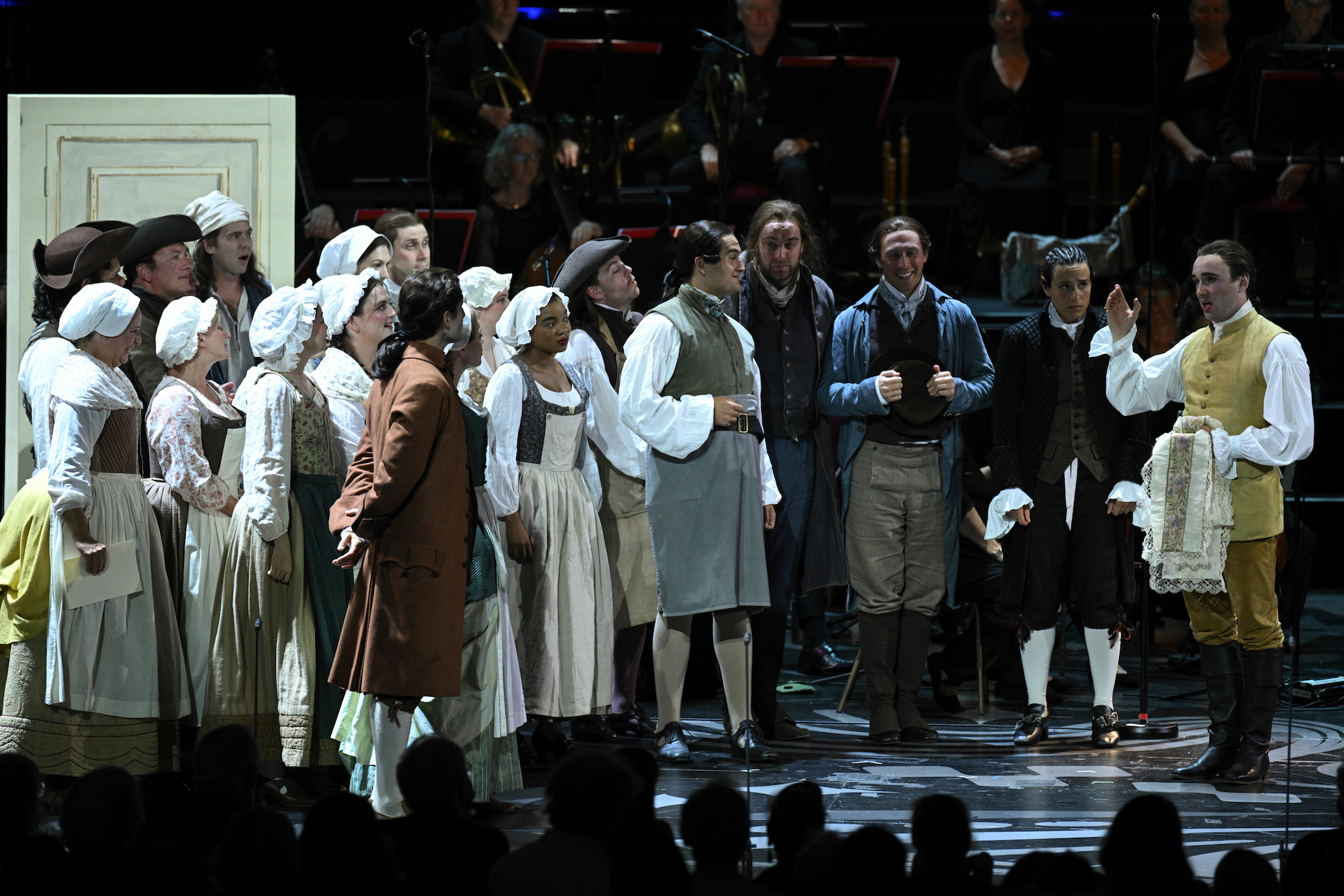 In the choral scenes (pictured above), well-judged movements made up for limited forces, while each part in the great ensembles kept clarity and definition even in this huge arena. As the genuine merriment (not polite titters) that swept the hall proved, the comedy of this satisfying Figaro survived displacement to Kensington. So too did its pathos and poignancy.
In the choral scenes (pictured above), well-judged movements made up for limited forces, while each part in the great ensembles kept clarity and definition even in this huge arena. As the genuine merriment (not polite titters) that swept the hall proved, the comedy of this satisfying Figaro survived displacement to Kensington. So too did its pathos and poignancy.
rating
Share this article
The future of Arts Journalism
You can stop theartsdesk.com closing!
We urgently need financing to survive. Our fundraising drive has thus far raised £49,000 but we need to reach £100,000 or we will be forced to close. Please contribute here: https://gofund.me/c3f6033d
And if you can forward this information to anyone who might assist, we’d be grateful.

Subscribe to theartsdesk.com
Thank you for continuing to read our work on theartsdesk.com. For unlimited access to every article in its entirety, including our archive of more than 15,000 pieces, we're asking for £5 per month or £40 per year. We feel it's a very good deal, and hope you do too.
To take a subscription now simply click here.
And if you're looking for that extra gift for a friend or family member, why not treat them to a theartsdesk.com gift subscription?
more Classical music
 BBC Proms: The Marriage of Figaro, Glyndebourne Festival review - merriment and menace
Strong Proms transfer for a robust and affecting show
BBC Proms: The Marriage of Figaro, Glyndebourne Festival review - merriment and menace
Strong Proms transfer for a robust and affecting show
 BBC Proms: Faust, Gewandhausorchester Leipzig, Nelsons review - grace, then grandeur
A great fiddler lightens a dense orchestral palette
BBC Proms: Faust, Gewandhausorchester Leipzig, Nelsons review - grace, then grandeur
A great fiddler lightens a dense orchestral palette
 BBC Proms: Jansen, Royal Concertgebouw Orchestra, Mäkelä review - confirming a phenomenon
Second Prom of a great orchestra and chief conductor in waiting never puts a foot wrong
BBC Proms: Jansen, Royal Concertgebouw Orchestra, Mäkelä review - confirming a phenomenon
Second Prom of a great orchestra and chief conductor in waiting never puts a foot wrong
 BBC Proms: Royal Concertgebouw Orchestra, Mäkelä review - defiantly introverted Mahler 5 gives food for thought
Chief Conductor in Waiting has supple, nuanced chemistry with a great orchestra
BBC Proms: Royal Concertgebouw Orchestra, Mäkelä review - defiantly introverted Mahler 5 gives food for thought
Chief Conductor in Waiting has supple, nuanced chemistry with a great orchestra
 Dunedin Consort, Butt / D’Angelo, Muñoz, Edinburgh International Festival 2025 review - tedious Handel, directionless song recital
Ho-hum 'comic' cantata, and a song recital needing more than a beautiful voice
Dunedin Consort, Butt / D’Angelo, Muñoz, Edinburgh International Festival 2025 review - tedious Handel, directionless song recital
Ho-hum 'comic' cantata, and a song recital needing more than a beautiful voice
 Classical CDs: Dungeons, microtones and psychic distress
This year's big anniversary celebrated with a pair of boxes, plus clarinets, pianos and sacred music
Classical CDs: Dungeons, microtones and psychic distress
This year's big anniversary celebrated with a pair of boxes, plus clarinets, pianos and sacred music
 BBC Proms: Liu, Philharmonia, Rouvali review - fine-tuned Tchaikovsky epic
Sounds perfectly finessed in a colourful cornucopia
BBC Proms: Liu, Philharmonia, Rouvali review - fine-tuned Tchaikovsky epic
Sounds perfectly finessed in a colourful cornucopia
 BBC Proms: Suor Angelica, LSO, Pappano review - earthly passion, heavenly grief
A Sister to remember blesses Puccini's convent tragedy
BBC Proms: Suor Angelica, LSO, Pappano review - earthly passion, heavenly grief
A Sister to remember blesses Puccini's convent tragedy
 BBC Proms: A Mass of Life, BBCSO, Elder review - a subtle guide to Delius's Nietzschean masterpiece
Mark Elder held back from blasting the audience with a wall of sound
BBC Proms: A Mass of Life, BBCSO, Elder review - a subtle guide to Delius's Nietzschean masterpiece
Mark Elder held back from blasting the audience with a wall of sound
 BBC Proms: Le Concert Spirituel, Niquet review - super-sized polyphonic rarities
Monumental works don't quite make for monumental sounds in the Royal Albert Hall
BBC Proms: Le Concert Spirituel, Niquet review - super-sized polyphonic rarities
Monumental works don't quite make for monumental sounds in the Royal Albert Hall
 Frang, Romaniw, Liverman, LSO, Pappano, Edinburgh International Festival 2025 review - sunlight, salt spray, Sea Symphony
Full force of the midday sea in the Usher Hall, thanks to the best captain at the helm
Frang, Romaniw, Liverman, LSO, Pappano, Edinburgh International Festival 2025 review - sunlight, salt spray, Sea Symphony
Full force of the midday sea in the Usher Hall, thanks to the best captain at the helm
 Elschenbroich, Grynyuk / Fibonacci Quartet, Edinburgh International Festival 2025 review - mahogany Brahms and explosive Janáček
String partnerships demonstrate brilliant listening as well as first rate playing
Elschenbroich, Grynyuk / Fibonacci Quartet, Edinburgh International Festival 2025 review - mahogany Brahms and explosive Janáček
String partnerships demonstrate brilliant listening as well as first rate playing

Add comment